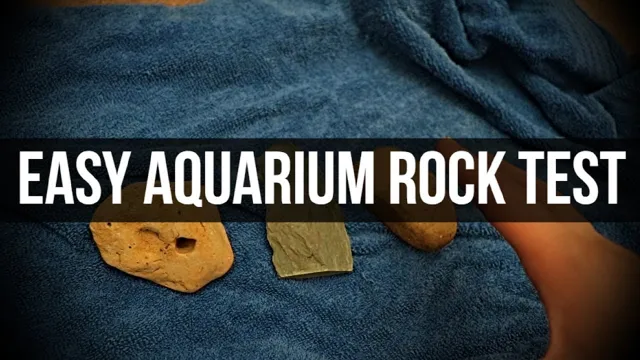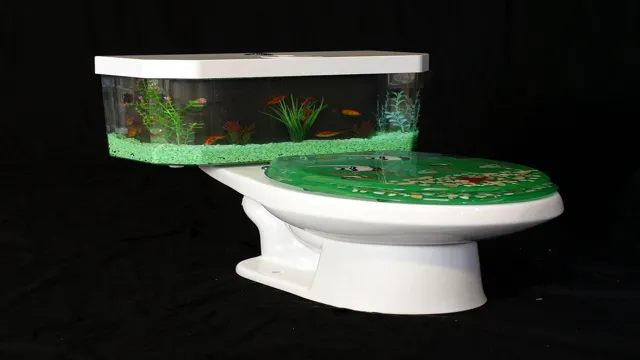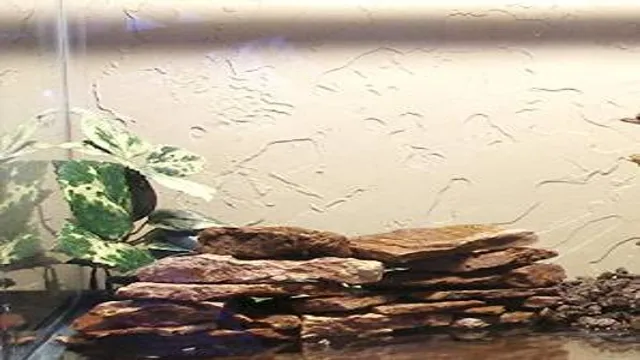As an aquarium enthusiast, one of the factors you must consider when setting up your aquarium is choosing the right rocks. Rocks not only serve as decoration but also create favorable conditions for the aquatic creatures. However, not all rocks are suitable for aquariums because some can release harmful substances, leading to fatal consequences.
That’s why it’s important to test rocks before adding them to your aquarium. In this blog post, we’ll discuss everything you need to know about testing rocks for aquarium use. From identifying the right rocks to the testing process and the tools you need, we’ve got you covered.
So, grab a snack, let’s dive in!
Types of Rocks Safe for Aquariums
If you’re planning to add rocks in your aquarium, it’s important to ensure that they are safe for your aquatic pets. To do this, you can test them for aquarium suitability using a simple acid test. Take a small piece of the rock and drip a little white vinegar on it.
If you notice fizzing or bubbling, the rock may contain harmful materials such as carbonates, or it may alter the pH balance of your tank water. Therefore, you should avoid using it in your aquarium. On the other hand, rocks such as quartz, granite, lava rock, and sandstone are considered safe for aquariums as they do not react with water or release any harmful substances.
Before adding rocks to your aquarium, ensure that they are properly cleaned and disinfected to prevent any contamination or infection to your aquatic pets. Overall, it’s crucial to test and choose the right types of rocks for your aquarium to create a safe and healthy habitat for your fish, plants, and other aquatic pets.
Identifying Safe and Unsafe Rocks
When it comes to selecting rocks for your aquarium, it is crucial to choose the ones that are safe for your fish and other aquatic life. Some common types of rocks that are safe for aquariums include lava rocks, quartz, granite, and slate. These rocks have neutral pH levels and do not contain any harmful substances that can leach into the water.
Lava rocks are lightweight and porous, providing a natural place for beneficial bacteria to grow and thrive. Quartz, on the other hand, has a smooth texture that makes it an excellent choice for aquascaping. Granite is a durable and versatile rock that can be used in a variety of aquarium setups, while slate is a flat and smooth rock that can be used for creating caves or building structures.
It is essential to avoid using rocks that can affect the water chemistry and harm your aquatic pets, such as limestone or sandstone, which can significantly increase the pH level in your aquarium. Additionally, avoid using any rocks that may contain metals or other harmful substances that can be toxic to your fish. When selecting rocks for your aquarium, it is crucial to research the different types and their properties to ensure that you are creating a safe and healthy environment for your aquatic life.
By choosing rocks that are safe for aquariums, you will not only provide a comfortable and healthy living space for your fish but also create a stunning underwater landscape that you can enjoy every day.

Common Examples of Safe Rocks
When adding rock decor to your aquarium, it’s crucial to choose the right types of rocks to ensure the safety of your aquatic life. Some common examples of safe rocks include lava rock, shale, and slate. Lava rocks are popular due to their porous texture, which offers a space for beneficial bacteria to grow and aid in the nitrogen cycle.
Shale and slate are popular for their flat surfaces, which provide an ideal substrate for aquatic plants to attach and grow. It’s essential always to check with a reputable aquarium supplier or expert to confirm the safety of any rock before adding it to your tank. Using safe rocks in your aquarium can add aesthetic value and also promote a healthy and thriving aquatic ecosystem. (See Also: How to Filter Marine Aquarium: A Beginner’s Guide to Choosing the Best Filtration System)
Preparing Rocks for Aquarium Use
If you’re preparing rocks for your aquarium, you may wonder how to test them for safety. First and foremost, do not use any rocks that contain metals or minerals that can be harmful to your fish. You can test rocks by dropping them into a solution of vinegar and water.
If the rock fizzles or bubbles, it contains calcium carbonate, which could alter the pH levels of your aquarium. You should avoid using these rocks. Additionally, ensure that the rocks are thoroughly cleaned and scrubbed before placing them in the aquarium to remove any dirt, debris, or potential harmful bacteria.
Always err on the side of caution when selecting rocks for your aquarium and prioritize the safety of your fish.
Cleaning and Disinfecting Rocks
Looking to add some rocks to your aquarium? It’s important to know how to properly clean and disinfect them before adding them to the tank. The first step is to rinse them thoroughly with water to remove any loose debris or dirt. Then, you can soak them in a solution of water and aquarium salt for a few hours to help remove any bacteria or algae.
After soaking, give them another rinse with clean water and dry them completely before placing them in the tank. It’s important to note that some rocks may not be suitable for aquarium use, as they may contain metals or other harmful substances that could harm your fish. Always do your research and choose rocks specifically intended for aquariums.
With the proper cleaning and preparation, your rocks can make a beautiful and functional addition to your underwater world.
Preventing Algae and Bacteria Growth
If you’re setting up a new aquarium, it’s crucial to know how to prepare the rocks you want to use in it properly. Otherwise, you might end up with an algae and bacteria bloom, which can be harmful to your fish and plants. The first step is to wash the rocks thoroughly with freshwater, ensuring there’s no dirt, dust, or debris that could contaminate your tank.
Then, boil the rocks for about 20 minutes to remove any microorganisms that may be harboring on their surfaces. After that, let them cool down and soak them in a bleach and water solution for ten minutes to kill off any remaining bacteria or algae spores. Rinse the rocks again with clean water and let them air-dry for a few days.
This process may seem time-consuming, but it’s worth it to keep your aquarium safe and healthy. Don’t forget to do regular water changes and maintenance to ensure your aquatic pets have a happy and thriving environment.
Checking Rock Porosity
Before using any type of rock in your aquarium, it is important to check its porosity. The porosity of a rock refers to the amount of tiny holes or pores it has, which can be important for the health of your aquarium. Rocks with high porosity are beneficial as they provide a place for beneficial bacteria to grow and thrive, which can help keep your aquarium clean and healthy.
On the other hand, rocks with low porosity can be problematic as they can trap harmful chemicals and bacteria, leading to poor water quality. To check the porosity of a rock, simply pour a small amount of water onto it. If the rock absorbs the water quickly, it is likely highly porous and safe for use in your aquarium. (See Also: How to Make a Simple Aquarium Background: Easy and Affordable DIY Guide)
However, if the water sits on top of the rock, this is a sign that it may have low porosity and is not the best choice for your aquarium. So, before adding rocks to your aquarium, take the time to check their porosity and ensure that they are the right fit for your aquatic ecosystem.
Testing Rocks for Aquarium Safety
If you’re planning on adding rocks to your aquarium, it’s essential to properly test them for safety before introducing them to your fish. Begin by examining the rock’s appearance, taking note of any cracks or sharp edges that could potentially harm your fish. Next, conduct the vinegar test by applying a few drops of white vinegar to the rock’s surface.
If it bubbles or fizzes, the rock contains calcium carbonate and is not suitable for aquarium use. It’s also important to avoid rocks that contain metals or minerals that could leach into the water and harm your fish. Overall, it’s worth taking the time to properly test any rocks before adding them to your aquarium to ensure the safety and health of your aquatic pets.
Acid Test for Aquarium Rocks
If you are planning to add rocks to your aquarium, it is crucial to ensure they are safe for your fish and other aquatic pets. The acid test is a simple way to check if a rock is suitable for your tank. This method involves placing a drop of vinegar on the rock’s surface and observing its reaction.
If the rock fizzes or bubbles, it could release harmful chemicals into the water, making it unsafe for your animals. On the other hand, if the rock remains unchanged, it is most likely safe to use in your aquarium. Remember to soak the rock for a few days before testing it since it removes any surface contaminants that can affect the results.
Keep in mind that not all types of rocks are suitable for aquariums, so it’s essential to do your research before selecting one. Using river rocks or aquarium-safe stones is your best bet to ensure the safety and well-being of your aquatic pets.
Electrical Conductivity Test
If you’re planning on using rocks in your aquarium, it’s important to make sure they’re safe for your aquatic friends. One way to test the safety of rocks is by conducting an electrical conductivity test. This is done by placing a small sample of the rock in a solution of distilled water and measuring the conductivity of the water with an electrical conductivity meter.
If the conductivity is high, it could indicate that the rock contains minerals or metals that could potentially harm your fish and other aquatic life. If the conductivity is low, it’s a good indication that the rock is safe to use. Keep in mind that this test isn’t foolproof and other tests may also be necessary to ensure the rocks are aquarium safe.
Overall, taking the time to test the rocks beforehand can save you from potential harm to your aquatic ecosystem.
Conclusion and Best Practices
In conclusion, testing rocks for your aquarium is like choosing a new roommate for your house. You want someone who is clean and compatible with your lifestyle. Similarly, you want a rock that won’t disrupt your aquarium’s ecosystem and won’t release harmful toxins. (See Also: How to Install a Submersible Pump in Aquarium: A Step-by-Step Guide)
By following the steps mentioned above, you can ensure that the rocks you choose will be great additions to your underwater world. Remember, in the world of aquariums, testing rocks = choosing the perfect roommate!
FAQs
What are the common rocks used in aquariums?
The most commonly used rocks in aquariums are lava rock, slate, quartz, and granite.
How do I know if a rock is safe for my aquarium?
To test if a rock is safe for your aquarium, pour vinegar on it. If it bubbles or fizzes, do not use it. Additionally, research the specific rock to ensure it is not harmful to aquatic life.
Can I use rocks I find outside in my aquarium?
It is not recommended to use rocks found outside in your aquarium as they may contain harmful bacteria or chemicals. It is safer to purchase and test rocks specifically made for aquarium use.
How do I clean rocks for my aquarium?
To clean aquarium rocks, scrub them with hot water and a brush. Do not use soap or any chemicals as they can harm aquatic life.
Is it necessary to test rocks before adding them to my aquarium?
Yes, it is important to test rocks before adding them to your aquarium to avoid any potential harm to your aquatic life.
How can I sterilize rocks for my aquarium?
Boil the rocks in a pot of water for 10-15 minutes to sterilize them before adding them to your aquarium.
Can I use rocks as a substrate for my aquarium plants?
Yes, some rocks can be used as a substrate for aquarium plants but research the specific rock to ensure it will not alter the pH or water chemistry in your aquarium.







